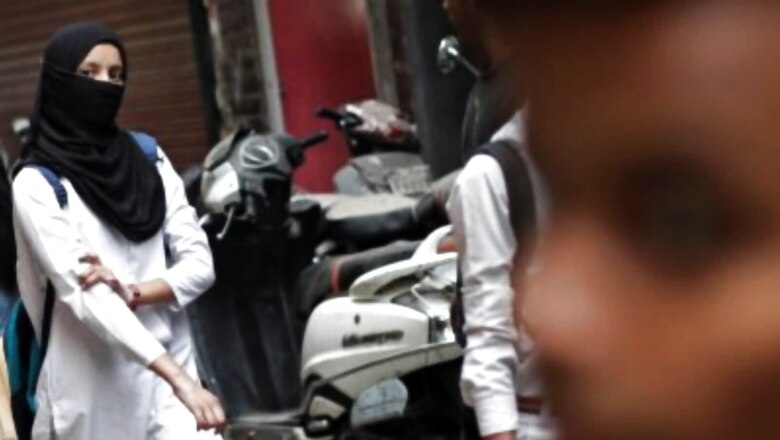
views
Who would have thought that in January 2022, after two years of a pandemic during which in-person classes and school education were hit immeasurably, six girls in Udupi will decide that what matters most to them is that they attend classes in hijab or not at all?
But here we are. These girls insist they are willingly wearing the hijab, which is essential to them and their ‘fundamental’ right guaranteed by the Constitution.
But as they said in a conversation to me, it is also a matter of their ‘maan-maryada’.
And that brings us to the fundamental premise of the head covering.
The hammer of patriarchy falls the hardest on Hindus and Hindus alone in India. It is believed that since Hindus are larger in number somehow their emotions concerning their faith and traditions are less vulnerable and therefore, they should be more open to criticism. Most other religious groups are left to take care of themselves — lest their sentiments be hurt.
All of this while we claim to be secular and hold no religion above another.
It is precisely this fig leaf that has run the discourse in India and that is being pushed against by some sections of Hindu society, and the secularists are unhappy.
But most Hindus are also most critical of themselves and their own practices. No wonder then, the religion is the least dogmatic with a constant conversation on what is good and not as a society. In the face of the hijab row, the question that comes to mind once again is, where are the progressive voices in the minority communities? Where are the Muslim thought leaders who are raising their voice against young girls wearing hijab? Isn’t the hijab or any additional covering mandated for women essentially patriarchal?
In most such cases, it is the families and communities that come into focus as they are the ones that usually insist that girls be modest. They are also easier to question. The state of society at large can be lamented upon.
In this case though, strangely it is the girls themselves who are fighting for their ‘right’ to wear hijab in classes. That cleverly makes it harder to question. But do these girls have an independent view of the practice and its implications and must this right be exercised inside a classroom?
While the court will decide if this is indeed a right or not, this brings into focus recent efforts globally to project the hijab as some sort of power movement among Muslim women. The hijab has been promoted, even by ‘feminists’ as a choice, completely disregarding that it comes from religious philosophy and is dished out to women from a young age.
Deeply intrinsic to this recent projection of hijab being a ‘choice’ is the embedded suggestion that questioning hijab is somehow Islamophobic. So, millions of Muslim women themselves fighting against hijab globally, and in dominantly Islamic countries, are Islamophobic?
Any woman opposing the idea that women must behave modestly to avoid sexualisation and ill advances of men are Islamophobic? It is seriously twisted.
Many pro-hijab women argue that those who oppose the head cover are basically loose people who believe in sexualisation of women — either women themselves or men. This couldn’t be further from the truth.
Dressing according to your surroundings is not a bad thing. Also, women need not be in your face with their body to be liberated and free. So, nobody is arguing for skimpy clothing. Neither are mini skirts a symbol of progress. Women need to be comfortable in their skin — regardless of the amount of clothing they have on. And certainly, no relationship must be made between ‘lust’ in men to whether a women’s head is covered or not.
How is it that people, especially women, are defending the hijab as a choice without discussing the most basic aspect that the hijab is mandated as a means of protection from men? And how do these voices call themselves ‘liberal’, ‘progressive’ and even feminists? Most of these women don’t wear the hijab themselves or will ask their girl child to. Why are they not advising same to these protesting girls in Udupi? I haven’t heard a single so-called liberal women’s activist say — Forget the hijab, go to your classes!
The same section will assert how Hindu women keeping a fast for the long life of their husbands do so because of hundreds of years of ingrained patriarchy. They somehow forgot that ‘Karwa Chauth’ is also a choice that should be left to the adult married woman. But no, here it is important to ‘smash patriarchy’ but there is utter silence from all these progressive voices on the head cover or the face veil on a Muslim woman. They seep themselves in blatant hypocrisy batting for hijab instead and projecting it as a choice. It is these double-standards and constant hammering of Hindu traditions alone that is no longer tolerated, so Hindus have been deemed intolerant now.
In my conversation with two young girls protesting for their right to wear hijab in schools, they say clearly that this is something they do even at home, so there is no question of them going outside without it. They add, ‘We can’t even show our hair to our brothers, so how can we show to ‘gair mard’ (unrelated men)?’
These are the kind of arguments and fight for hijab that is being supported by ‘secular and liberal’ voices in a girl’s college! If these students don’t feel comfortable even in a girl’s school, what is the message that will go by supporting their assertion in co-ed institutions?
Modesty for women is not a concept that a school, of all places, needs to support or endorse. If anything, schools must be a medium to deconstruct misogyny, not tacitly promote it. Education may not be able to take care of a student’s atmosphere at home but the least it can do is provide a free environment to its pupils while in school.
News reports also show that these girls have accepted that they started insisting on wearing the hijab to their PU college in Udupi only in December 2021 when they realised there is no rule barring it. So much so that they are willing to sacrifice their education for it while they also plead that their exams are nearing. Not to forget they have also accepted that they were ‘counselled’ by Campus Front of India (CFI) post which clearly their position has hardened. It is also not lost on anyone that by now most protesting girls are actually wearing the full burqa and not just the head scarf.
Schools are particularly touchy about their uniforms for obvious reasons. Wearing a uniform instils uniformity, pride and discipline in young kids. Who doesn’t remember being reprimanded in school if your uniform and its presentation wasn’t top notch? Many schools, for example, even mandate what type of shoes are allowed or which colour of the ribbon one can use on braids.
Having said that, if a school doesn’t want to allow any signs of faith, that is up to that institution. If you dislike its rules, you can move to an institution where you are allowed to wear your symbols.
But let’s not pretend a thread on a wrist or a chain around your neck is the same as a head and neck cover.
Hijab is not an ordinary gender-neutral element of religion. It is important to remember, piety and modesty are two different things. The former is self-driven, the latter is imposed and only on women.
ALSO READ | Lesson from Iran: When It Starts with Hijab, It Doesn’t End Too Well for Women Empowerment
Isn’t it also laughable then, that on one hand pro-hijabists argue it is a matter of choice, but then also argue that it is mandated by Islam? This is precisely the argument made in court by the protesters. Aren’t they condemning millions of Muslim women who don’t wear the hijab?
Essential or not, why must a secular institution run by the government endorse a religious practice — one that interferes with school uniform and is also deeply misogynistic? Clearly the families of these girls didn’t have a problem with them studying without hijab in a girl’s college all this while. So why this assertion now? And why not fulfil this right in a minority institution if you want it now?
What is this insistence that minorities will have their unhindered space as mandated by personal laws and minority institutions in India but then also enforce those views in public state-run spaces? That possibly is the bigger political fight here. One that is being orchestrated by pushing fundamentalism within a community and by virtue of it exploiting fault lines within various groups.
Shivani Gupta is a senior journalist and co-author of ‘Ace against Odds’, Sania Mirza’s autobiography.
Read all the Latest Opinions here




















Comments
0 comment